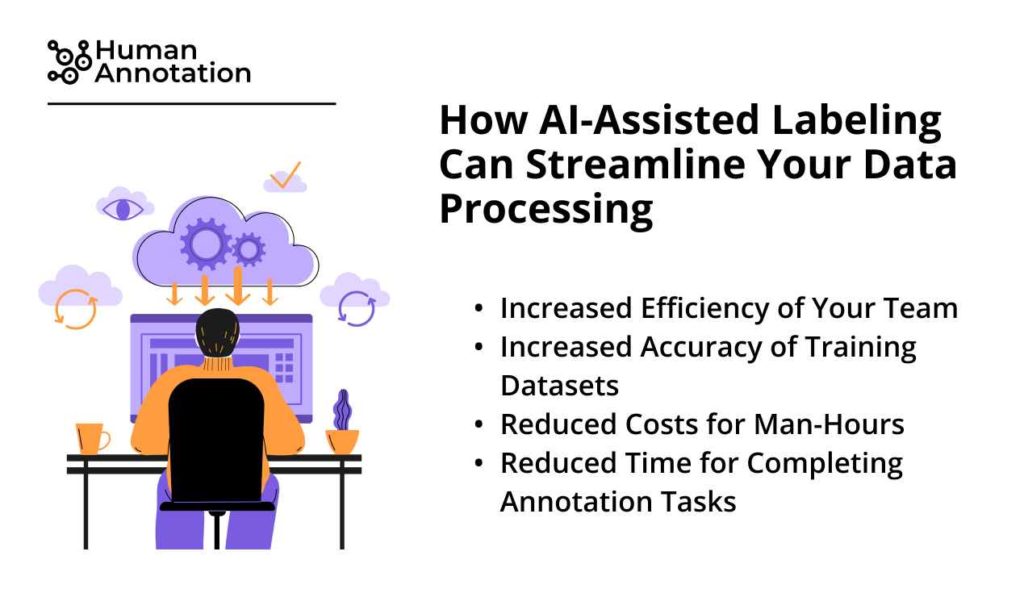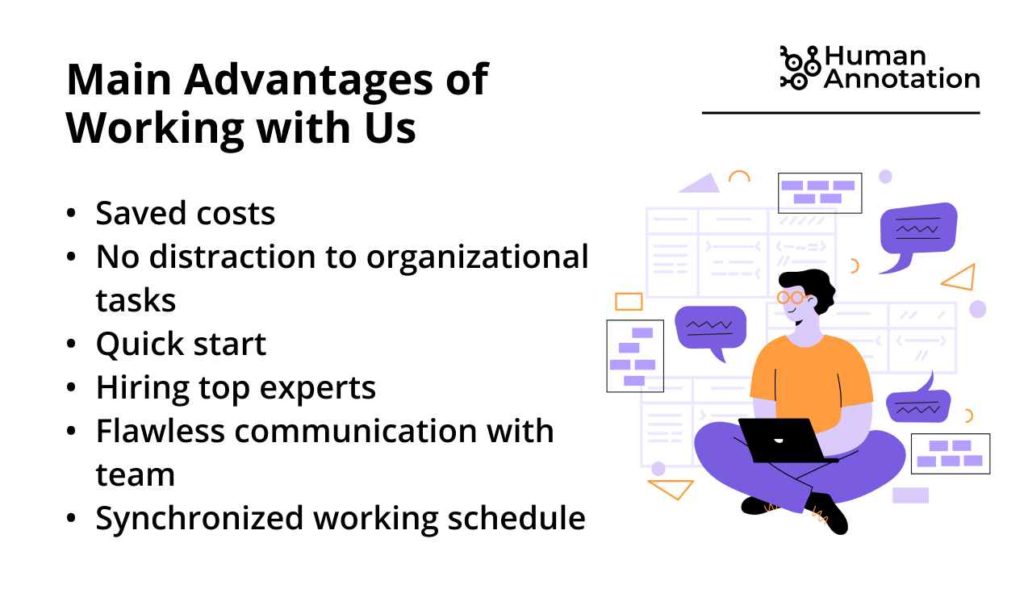
High-quality annotation of training data is the key to the success of AI-powered software. Still, even experienced annotators can’t always deliver accurate, consistent, and unbiased labeling time-efficiently. This is possible when humans use AI-assisted annotation tools. And from this article, you’ll learn more about this kind of data annotation services and check how to outsource them.
Introduction to AI Assisted Labeling
When labeling practitioners annotate objects manually, placing dots and lines on various elements, they spend time. Even though they’re skilled and well-trained, and their software is super handy, inaccuracies can happen. But annotation tools driven by Artificial Intelligence can automatically detect and tag items, while humans only need to make minor adjustments.
However, like any ML model, AI annotation software has to be trained. Data annotators process a small but representative dataset to teach the tool to identify critical patterns and approaches. Then it can process files with little supervision. For instance, the most challenging task is to tag elements on video because it’s split into hundreds of similar images (frames). But with an AI-assisted tool, you only process the first frame, and the algorithms will transpose tags to the following frames.
Uses of AI Assisted Annotation for Different Industries
AI-baked annotation services for AI ML models streamline the development of digital products in many industries. Here are a few examples:
AI Data Annotation in Security
Surveillance cameras set in many countries collect terabytes of video files. One of their purposes is to show the evidence of a crime once it happens. And only with a person who monitors the stream can these cameras help prevent violations and crimes. However, with AI-empowered functionality like sentiment analysis and object detection, cameras can alert security staff about potential threats. For instance:
- Keypoint annotation of human bodies can notice provocative movements or weird behavior of people before the conflict escalates.
- Polygon annotation of dangerous objects helps to detect knives and guns before someone decides to use them.
- Keypoint annotation of faces allows algorithms to recognize criminals and identify aggressive emotions that can incite a fight.
AI Data Labeling in Medicine
As the assisting technologies evolve, software development companies switch to AI-driven annotation services for computer vision. Their tools help visually impaired people identify colors, detect light sources, read texts, and recognize objects around them. By converting texts and images into words, these assisting instruments extend communication opportunities for partially sighted people.
Moreover, these tools help these humans perform routine tasks independently. Well-trained algorithms can alert mobile application owners about approaching public places or dangerous areas like construction works or crossroads. However, bringing these technologies to life requires thorough processing of large volumes of real-world images and videos. And only AI-baked annotation allows us to handle this task faster and more cost-effectively than manual labeling.
AI Annotation in Online Shopping
Shoppers appreciate helpful real-time communication with brands, so almost every online shop and e-commerce platform has a chatbot. This service can remind users about abandoned carts, inform them about a delivery, offer similar products, etc., maximizing your sales. Machines can detect buying intents in messages and react immediately. But to enable them to do it, you’ll need to teach your model Natural Language Processing (NLP) through AI text annotation.
Another popular way of promoting sales with AI is Augmented Reality (AR). Consumers buy furniture, cosmetics, clothes, footwear, and toys from sellers offering AR experience. It allows trying colors and styles, buying best-fitting shoes without wearing them, or checking how that bed looks in your sleeping room. With AR, shopping is fun, and it’s real due to human-in-the-loop AI annotation.
Need Professional AI-assisted Labeling Services? Get In Touch With Us!
Benefits of AI-Assisted Data Labeling
AI helps create unique applications making our lives comfortable and more manageable. We can leverage this technology due to AI and professionally labeled images, videos, texts, or audio files. But let’s check which advantages AI annotation and data labelling services bring to businesses.

Increased Efficiency of Your Team
With data annotation AI tools, your labelers will spend less time on each file. For instance, they need around 7-8 seconds to mark a cuboid on an image and add the label manually. AI automation allows labelers to perform this task for 2-3 seconds and move to the next image without extra clicks.
However, tools can streamline the labeling process only when your team has clear guidelines with labeling criteria. It’s critical to train your AI-assisted annotation tools with accurate, consistent, and objective labels. Otherwise, your instrument will perform with errors and jeopardize the accuracy of the entire dataset.
Increased Accuracy of Training Datasets
In data annotation, accuracy shows how well ML algorithms categorize real-life objects and elements.l, performing specific tasks. And when data labelers use well-trained assisting tools, they minimize noise (irrelevant pixels), label item borders more precisely, associate keywords with the right intent, or define the mood of a song without bias.
The accuracy, however, isn’t something you reach once and keep it. This parameter depends on many factors, including diverse and balanced sample datasets, continuous training of the assisting annotation tools, and regular quality assurance. Data labelers need to communicate disputable cases and arrange cross-checks to ensure consistency in tagging items.
Reduced Costs for Man-Hours
Product owners always search for ways to cut costs on software development. And equipping their data annotation teams with AI-assisted labeling tools is a cost-effective measure. If you have 100,000 images to label and one person needs 5 seconds to process one picture manually, you’ll have to pay for approximately 140 working hours.
Let’s assume your AI tool allows doing the same task for 2 seconds; then the labor costs will equal only 56 person-hours. Though automation software for data labeling will be more expensive than manual tools, investing in AI-powered annotation instruments always pays off.
Reduced Time for Completing Annotation Tasks
The complementary benefit of your team’s improved performance is the reduced time for annotation. This way, you can create more training datasets during the same period and launch your product faster. Velocity is one of the critical success factors in the market of digital products. This industry evolves so rapidly that the concept of your AI-driven tool can get outdated before it goes live.
So leverage AI technologies to annotate your data fast, accurately, efficiently, and cost-effectively. And to make it even more budget-friendly, we offer outsourcing top AI data labeling professionals. Read on to learn more details and check the benefits of this cooperation format.
How to Outsource AI-Assisted Labeling Services
When you prefer AI data annotation outsourcing to employing in-house data labelers, you’ll find tens of providers. At a glance, they seem not to differ much, so you’ll only need to find the best price. However, there are many details that matter. For instance, how reliable this outsourcing partner is and how rapidly this company will assemble your team.
Also, it’s critical to determine which time zone your team will be located in and if they’ll speak English well. Will you have to pay in advance, how long will it take to get your annotation team ready, and what cooperation options will they offer? For example, our company has flexible cooperation models. Clients can outsource a dedicated team and hire only one data labeler.
Here’s how you can outsource AI data annotation services to us:
- We discuss your needs. Our managers will get in touch after you call us or send the contact form. They’ll ask for the details of your project: which type of annotation you need, how many practitioners you plan to hire, and by when. Also, we’ll discuss the rental and possible equipment costs. That’s why it’s critical to understand the approximate budget at this stage.
- You get the first CVs. Once we agree on the costs, terms, and team composition, our recruiters craft job descriptions and launch searching. They’ll source resumes of qualified experts and arrange interviews with your chosen candidates. We can do pre-screening and run HR or technical interviews if you wish to skip these steps, but all the processes and summaries remain transparent.
- We finalize your team. Once you confirm the final list of candidates, we will prepare and send them job offers. This is the time when we issue the monthly invoice. We always split the total amount into categories so you know exactly what you pay for. As you settle the bill, our HR team will start signing employment contracts, arranging office premises, and purchasing hardware and software.
Benefits of Working with Us

Why do businesses choose us as their annotation company for AI projects? There are a few reasons for this:
- Saved costs. The highest cost in hiring people is their salaries. But our outsourcing model helps you save on this because we work with data labeling AI experts based in Ukraine. Since the cost of living in this country is much lower than in the USA or Western Europe, payrolls are also lower. This allows companies to save up to 20% of investments.
- No distraction to organizational tasks. The cooperation model we offer lets project owners never worry about administrative issues. You won’t have to worry about transferring payrolls and taxes, submitting reports, paying rentals, allocating equipment, formalizing sick leaves, or arranging team-building events. Our team handles all the organizational issues, letting you focus on the workflow.
- Quick start. We rarely see clients who need to assemble their data annotation team in six months. Usually, they need people ASAP and count every week. And our recruiting approaches let us meet your requirements. So we create and regularly update lists of top professionals ready to start working. Also, we leverage popular job boards and social media to find experienced data labelers fast.
- Hiring top experts. Ukraine has been a popular destination for IT outsourcing for years. This country has become one of the leading IT hubs with hundreds of specialists with expertise, including data annotators. So we always keep talent pools to equip your project with experienced practitioners. In addition, we explore new platforms and grow our professional networks.
- Flawless communication with your team. Hiring specialists from AI data labeling companies based in non-English speaking countries may result in poor communication. However, all the specialists we hire for you will have at least a B1 level of English. This means they’ll be able to understand you when discussing issues or explaining their thoughts and ideas.
- Synchronized working schedule. One of the issues in managing remote teams is the difference in business hours. Most popular outsourcing destinations are 3-5 hours ahead of Western Europe and 10-12 hours ahead of the US. But Ukraine is located in the middle of Europe, which allows you to have the same working hours or share most of them. In case of urgency, your team stays accessible even after their business hours.


